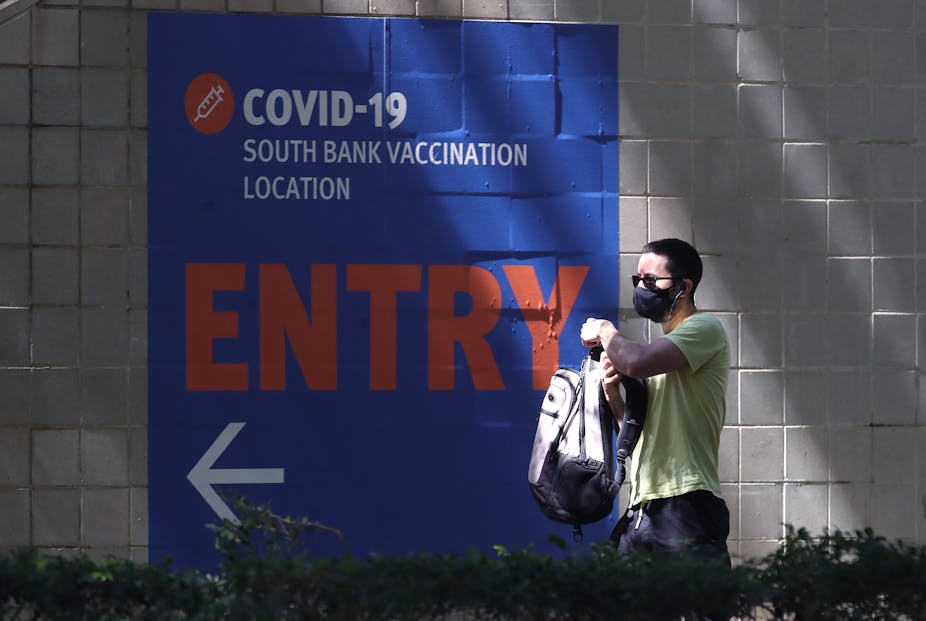The Doherty Report, released 10 August, underpins the vaccination targets in the federal government’s national reopening plan of 70% and 80% of the population aged over 16. However, since we began this modelling, we have seen large outbreaks in New South Wales and Victoria. These outbreaks prompt questions about how community prevalence affects reopening plans.
The interim report, released on Saturday, addresses the impact of higher daily case numbers when we reach the 70% and 80% threshold; how public health and social measures could be applied between 70% and 80%; and differences between the strategy in each state and territory.
Our first report recommended ongoing “low” restrictions throughout the reopening phase to support vaccination and public health responses. The new results show that if a state or territory has high caseloads when it reaches 70% coverage, cases could still grow quickly at this level of restrictions, leading to a much larger outbreak.
Applying “medium” restrictions until 80% coverage is reached, will greatly reduce the likelihood and potential size of an outbreak. From the 80% coverage level, vaccines do more of the heavy lifting to control infection spread, and so only low level restrictions are likely to be needed.
What does ‘overshoot’ mean and how can we prevent it?
Overshoot refers to the people who get infected as the pandemic is slowing.
When enough of the population is immune to COVID, through a combination of vaccination and past infection, the disease can’t spread any further, and the proportion of population immunity required to prevent spread is reduced through public health and social measures, and contact tracing.
So, as we increase vaccine coverage, there will come a point where each COVID-infected person transmits to fewer than one person on average. But epidemics have momentum and take time to stop. Anyone who gets infected as the epidemic is slowing is part of the overshoot. The danger of significant overshoot is that it will greatly increase the total number of people infected, leading to more hospitalisations and deaths.
By keeping community prevalence low as we transition to high vaccination coverage, we reduce overshoot and keep the total number of infections low.

Read more: COVID will likely shift from pandemic to endemic — but what does that mean?
Differences by state and territory
When Australia reaches 70% and 80% coverage, every state and territory will be in a different position, both in their own coverage and in COVID prevalence. That means every state and territory will have their own path through these transition phases, as allowed for in the National Plan.
With higher case numbers, there will likely be stronger restrictions for longer, while with lower case numbers the contact tracing system is likely to be more effective and able to control outbreaks with lighter restrictions.
Beyond COVID prevalence, there are also differences in the potential for COVID to spread in each state and territory, which we track using the transmission potential (TP) metric. These differences are driven by a combination of demographics and because baseline behaviours are markedly different across Australia. Higher TP means faster spread, and a TP below 1 means cases should decline.
Projecting the TP when we reach 80% coverage, we predict that if “baseline” population behaviour in Victoria is similar to December 2020, the TP would be 1. However, for Western Australia the TP would be 1.6, if we assume people behave as they did in March 2021. These differences further support our recommendations that ongoing “low” restrictions will provide a more stable level of disease control moving forward.
Situational assessment of TP and short term COVID infection projections are provided weekly for all jurisdictions and will be essential to support decision making over the coming weeks and months.
The National Plan provides flexibility for states and territories to adjust restrictions and policies to manage local case numbers throughout the reopening phases for best outcomes.
Where to from here?
The modelling has aimed to inform broad national targets for reopening, but there are many more granular issues to explore and work through at state and local levels to give more detailed advice. These ongoing projects include helping to define sustainable and effective public health responses; optimising local disease control through vaccines and other measures in at-risk populations and settings; and supporting plans to reconnect Australians with the wider world.
Contact tracing will need to shift from an extinction model — chasing down every last contact — to a more sustainable model to identify efficient ways to reduce transmission in the community. We have already seen New South Wales and Victoria moving to text messages to initially notify cases, rather than a phone call.
Fresh research about the severity of the Delta variant confirms that it is more likely to lead to hospitalisation and death than the Alpha variant. This new evidence further endorses our recommendations for a multi-pronged approach to disease control to keep case numbers as low as possible so the health system is able to manage anticipated clinical loads. We will factor this and other emerging evidence into ongoing modelling, including regular situational assessments.
As we move towards reopening, it is critical we carefully monitor the epidemic situation and continually update models as the situation unfolds. If cases grow faster than expected, we should be flexible to either alter restrictions, postpone lifting of restrictions or retreat if indicated.
On the other hand, if baseline health measures or vaccines are more effective than we expect, we may find ourselves in a position to lift restrictions earlier than anticipated.
While there are uncertainties about our future, there is one thing we are certain of. The higher our fully vaccinated coverage goes above 80%, the easier it will be to control COVID, enabling a return to a (COVID) normal life.

